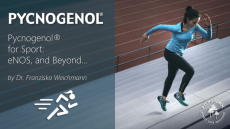Science, not body image marketing, should drive sports nutrition, expert says

Susan Kleiner, PhD, is a practicing nutritionist and principal in the consulting firm High Performance Nutrition who advises female athletes in the WNBA and a professional soccer league. Kleiner has consulted on product formulation and briefly ran her own brand called Vynna.
“What I learned in those two years of running Vynna is that women are hungry for real information. They desperately want products that are specifically made for them. Instead they get something where they’ve just taken the creatine out, put fewer calories in, and it’s wrapped in pink,” Kleiner told NutraIngredients-USA.
Misogynistic messaging
Kleiner said the decision-making process in the development of sports nutrition brands is heavily dominated by men. That colors the underlying principles. Why would a woman want to get stronger, or faster, or more lean? Is it for her own purposes, or is it for the benefit of men, to increase her sexual attractiveness? Is this about being healthy and athletic, or becoming better eye candy?
“It’s very misogynistic messaging. These are companies that are mostly run by men. Instead of lifting women up, this is all about keeping women down. The message seems to be that women should just shrink and disappear; it’s not about helping them become strong and successful. This is not subliminal. This messaging is overt, and it’s horrible,” Kleiner said.
Kleiner said sports nutrition products exist in a cultural milieu that has been rapidly changing, and for women not necessarily for the better. It’s true there is more female sport now that every before. There are more slots for female athletes at the Olympics, where sports like women’s hockey have been added. And in the United States, female sports opportunities have been boosted by the gender equality law known as Title IX, which states among other things that if public funds are used to support athletic teams connected to educational institutions, those funds need to be apportioned fairly between men’s and women’s sports. That has helped female athletes, but paradoxically has allowed a glass ceiling to creep in, Kleiner said. According to a recent analysis by The New York Times, when Title IX was enacted in 1972, more than 90% of the head coaches of women’s college teams in two dozen sports were women. Now that has shrunk to 40%.
“It used to be women’s sports teams were coached by women. Now with Title IX coming in, women’s sports in college has become big business, and you increasingly see these teams coached by men,” Kleiner said.
Finances complicate picture
This emphasis on body image is also exacerbated by the difficult financial position female athletes find themselves in after college. American female pro athletes and their leagues are decidedly second class citizens, Kleiner said. While the big names, like top flight WNBA stars or women who’ve played on the U.S. women’s soccer World Cup teams, can score hefty contracts, most of the other players in those leagues just barely scrape by and must work second jobs or punish their bodies by competing year round by playing in leagues overseas.
“Some of my athletes have finished a season in France and then have gone straight into a season here in the U.S. They ‘recover’ on the plane,” Kleiner said.
Another way in which female athletes supplement their income is through endorsements. And appearing sexy figures into that as well. Not every woman who might want to use a sports nutrition product has aspirations to be a competitive bikini model, but many are forced to keep those concerns in mind.
“My pro athletes, where body image is no part of their sport, are extremely concerned about body image,” Kleiner said.
If a sports nutrition brand wanted to truly become a leader in the field, it would need to step up to the plate to advocate for changes in this system, Kleiner said. And it would need to take a hard look at what it’s putting inside the bottles.
Little data to go on
That formulation side of the coin is complicated by the dearth of data specific to how best to fuel female athletes, Kleiner said. There is some research indicating that the bodies of high performing female athletes will preferentially fuel tissues of high metabolic need—i.e. working muscles, lungs, etc.—at the expense of more mundane functions such as maintaining adequate bone mineral density, maintaining normal endocrine function, etc. One of the most recent studies, a detailed observation of one high level junior female triathlete, was done by Jaci VanHeest, PhD, of the University of Toronto. VanHeest will be one of the presenters along with Kleiner at a session moderated by Shawn Arent, PhD of Rutgers University, during a pre conference program on the question of formulating for the female athlete at the meeting next month put on by the International Society of Sports Nutrition in Phoenix, AZ. Watch NutraIngredients-USA next month for coverage of the ISSN conference.
“The point of the pre conference session is that women are not just men with hormone issues," Kleiner said. She added while the science of the female athlete is developing, there is much work yet to be done.
“There are missing data points in all of this,” Kleiner said.
Online sports nutrition event
Dr Arent will be appearing on an online panel on this week’s NutraIngredient-USA’s online Sports Nutrition event, which is scheduled for Thursday, May 18. For more information or to register for the event, click here.
In addition to her consulting business, Kleiner is the author of nine books including Power Eating, which is now in its fourth edition. For more information, click here.


















